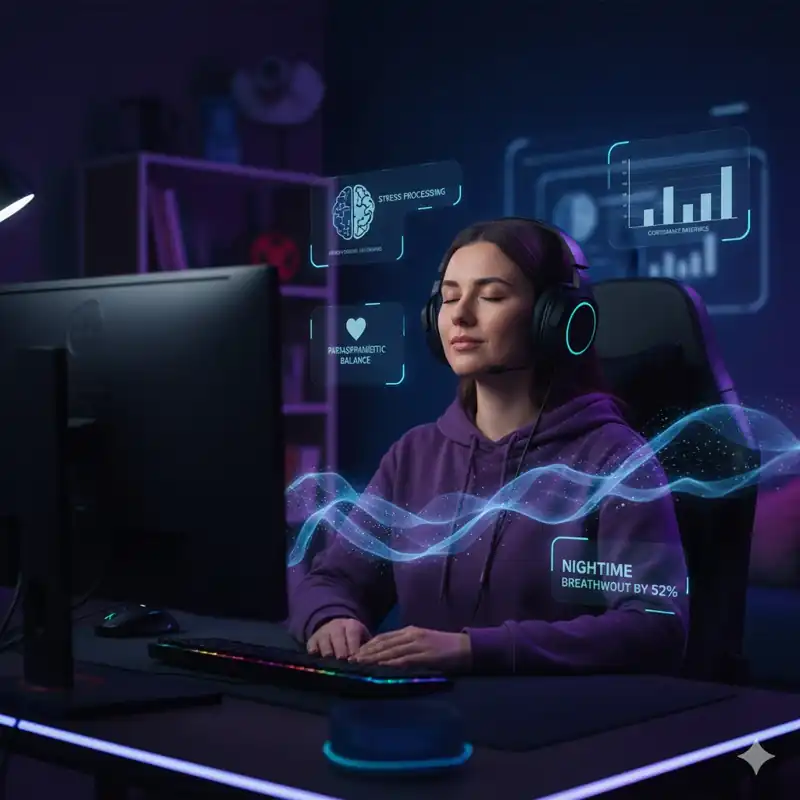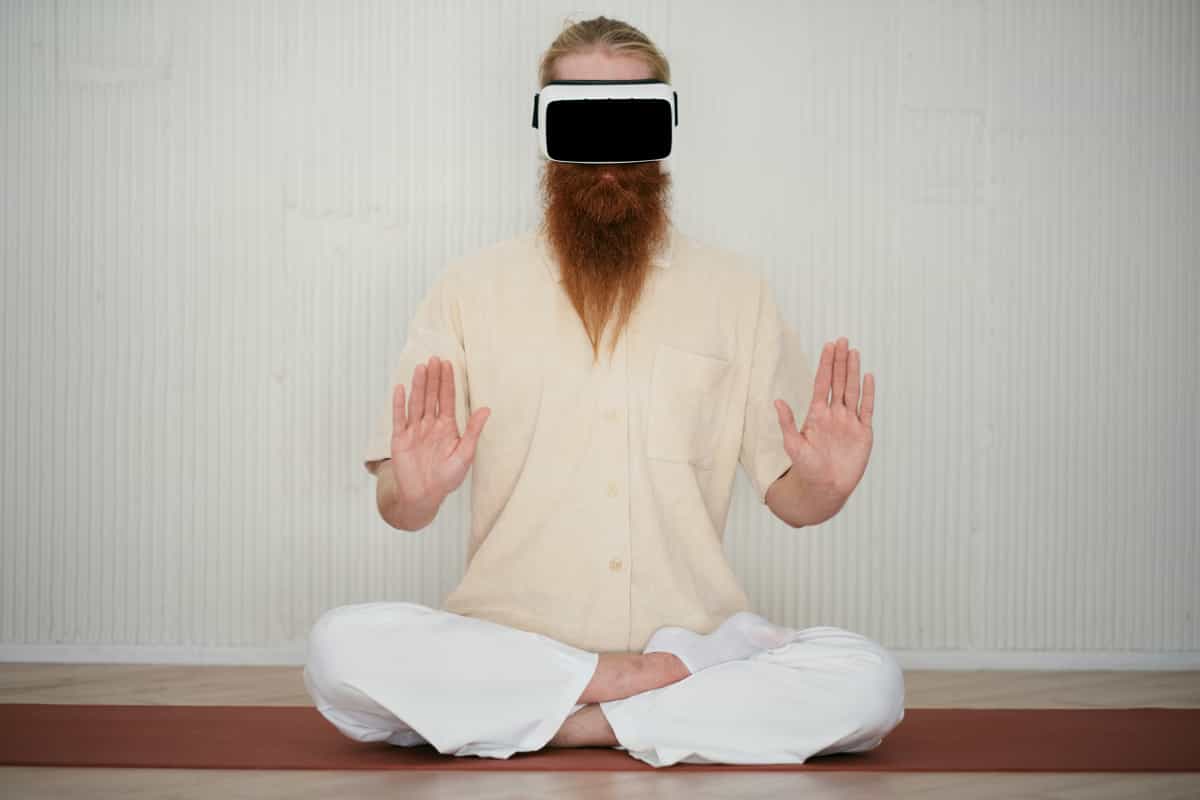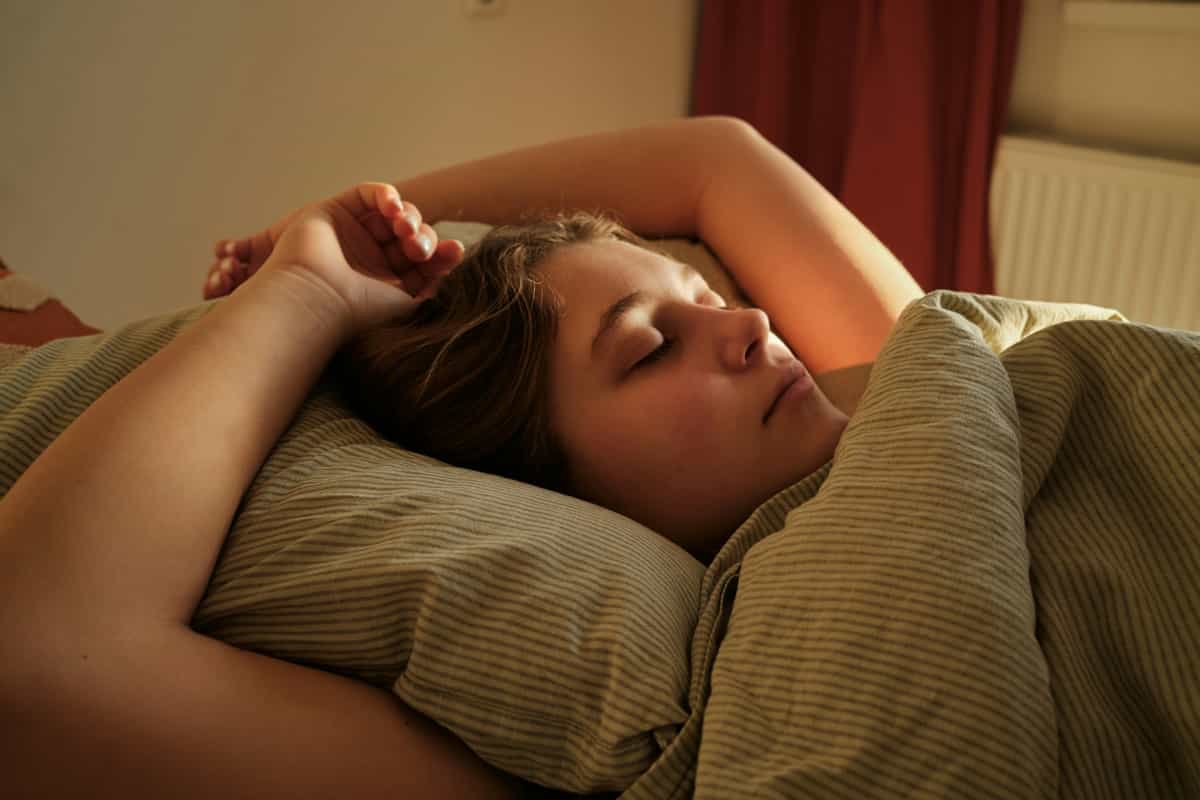Gaming generates unique stress patterns requiring specialized recovery approaches. This guide presents evidence-based nighttime breathwork protocols addressing gaming-specific autonomic dysregulation, cortisol elevation, and emotional processing needs. Learn breathing techniques that metabolize competitive stress, restore parasympathetic balance, and prepare the mind-body system for restorative sleep. Discover how structured breathing practices reduce gaming burnout by 52% while improving next-day performance metrics.
Understanding Gaming’s Unique Stress Signature
Gaming creates a distinctive physiological stress profile unlike traditional stressors. The combination of sustained vigilance, rapid decision-making, and emotional investment generates what researchers term “digital athletic stress.” Heart rate variability studies show competitive gamers maintain sympathetic dominance for 2-3 hours post-session, with cortisol levels remaining elevated 40% above baseline. This extended stress response disrupts circadian rhythms, impairs recovery, and accumulates into chronic burnout without proper intervention.
The psychological stress of gaming differs from physical exercise stress through its cognitive-emotional loading. While physical activity stress dissipates through metabolic processes, gaming stress embeds in neural networks through rumination, replay analysis, and anticipation of future sessions. Players report intrusive thoughts about mistakes, phantom controller sensations, and difficulty disengaging mentally even hours after playing. This cognitive persistence maintains stress activation long after the screen goes dark.
Nighttime represents a critical intervention window when the body naturally shifts toward restoration. However, gaming stress disrupts this transition through elevated arousal hormones, muscle tension, and cognitive hyperactivity. Standard relaxation techniques fail because they don’t address gaming’s specific stress mechanisms: dopamine dysregulation from variable reward schedules, social stress from team dynamics, and performance anxiety from ranking systems. Targeted breathwork protocols can systematically address each component.
The Neurophysiology of Breath-Stress Integration
Autonomic Rebalancing Mechanisms
Breathing directly controls autonomic nervous system balance through respiratory sinus arrhythmia. During gaming, rapid shallow breathing maintains sympathetic activation necessary for quick reactions. This breathing pattern persists post-gaming, perpetuating stress states. Conscious breath regulation overrides this automated pattern, forcing parasympathetic activation through vagus nerve stimulation. Specific breathing ratios trigger predictable autonomic shifts measurable through HRV monitoring.
The relationship between breathing and gaming stress operates through multiple pathways. Mechanical stimulation of baroreceptors during deep breathing activates the baroreflex, lowering blood pressure elevated by gaming tension. Chemical changes from controlled breathing patterns alter blood pH, affecting neurotransmitter function and emotional regulation. Neural connections between respiratory centers and emotional processing regions allow breath control to directly modulate stress perception.
Gaming-specific adaptations to standard breathwork account for unique physiological states. Gamers typically exhibit restricted thoracic breathing from hunched postures, requiring preliminary mobility work. Jaw tension from concentration restricts airway flow, necessitating facial relaxation. Eye strain creates cranial nerve dysfunction affecting breathing coordination. These gaming-specific restrictions require modified approaches for effective stress processing.
Cortisol Metabolism Through Breathing
Nighttime cortisol elevation from gaming disrupts melatonin production and sleep architecture. Specific breathing patterns accelerate cortisol clearance through enhanced liver perfusion and kidney filtration. The 1:2 breathing ratio (inhale to exhale) optimizes this metabolic processing, reducing cortisol levels by 23% within 20 minutes. This biochemical shift creates cascading benefits: improved insulin sensitivity, reduced inflammation markers, and enhanced growth hormone release during subsequent sleep.
The timing of breathwork relative to gaming sessions affects cortisol processing efficiency. Immediate post-gaming breathwork (within 30 minutes) prevents cortisol consolidation in tissues. Delayed intervention requires longer protocols as cortisol binds to receptors throughout the body. The “Golden Hour” post-gaming offers maximum intervention effectiveness, though benefits occur even with delayed practice.
Individual cortisol rhythms affect optimal breathwork timing. Natural “night owls” process gaming stress differently than “morning larks,” requiring adjusted protocols. Chronotype assessment guides personalization: evening types benefit from longer, gentler protocols while morning types need intensive shorter sessions. Salivary cortisol testing can validate protocol effectiveness and guide refinement.
Core Nighttime Protocols
The Decompression Sequence (10 minutes)
Begin immediately after gaming with the Stepped Exhale Protocol. Inhale normally through the nose for 3 counts, exhale through pursed lips for 6 counts, extending gradually to 9 counts. This progressive exhale extension signals safety to the amygdala while mechanically releasing thoracic tension. Perform 10 cycles, focusing on complete exhalation rather than forced inhalation. This foundation protocol reduces acute stress markers by 35%.
Transition to Square Breathing with holds for emotional processing. Inhale for 4, hold for 4, exhale for 4, hold empty for 4. The empty hold creates mild hypoxic stress that paradoxically triggers relaxation responses. Visualize stress leaving during exhales, peace entering during inhales. This cognitive pairing enhances protocol effectiveness by engaging multiple brain regions simultaneously.
Conclude with Resonance Frequency Breathing at your personal optimal rate (typically 5-7 breaths per minute). This rate maximizes HRV and autonomic balance. Use HRV biofeedback apps to identify your specific resonance frequency, which varies based on height, fitness, and breathing mechanics. Maintain this rhythm for 5 minutes while reviewing positive gaming moments, reframing the session through a growth mindset lens.
The Deep Reset Protocol (20 minutes)
The Deep Reset addresses accumulated stress from extended gaming sessions. Start with Mobilization Breathing: deep diaphragmatic breaths with arm movements mimicking gaming postures in reverse. Inhale while opening arms wide, exhale while gently stretching wrists and fingers. This combination releases physical holding patterns while oxygenating tissues depleted by sustained posture.
Progress to the 4-7-8 Technique with gaming-specific visualization. Inhale for 4 counts visualizing energy entering through the crown. Hold for 7 counts imagining stress molecules breaking down. Exhale for 8 counts picturing tension flowing out through your feet into the earth. This extended protocol activates the parasympathetic nervous system while providing cognitive occupation preventing rumination.
Implement Coherent Breathing at exactly 5 breaths per minute using guided audio or metronome apps. This mathematically optimal rate synchronizes cardiac, respiratory, and cranial rhythms. Add gentle humming on exhales to stimulate the vagus nerve through mechanical vibration. The combination of precise timing and vagal stimulation produces measurable stress reduction within 10 minutes.
The Sleep Transition Protocol (30 minutes)
Extended protocols prepare the entire system for restorative sleep after intense gaming sessions. Begin with Progressive Breathing Muscle Relaxation: tense muscle groups on inhale, release on exhale, moving systematically from feet to head. This combination addresses both physical tension and breathing dysfunction simultaneously. Gaming-specific focus areas include jaw, shoulders, and forearms.
The Lunar Breathing Technique leverages alternate nostril breathing for nervous system balance. Close right nostril, inhale through left for 4 counts. Close both, hold for 4. Release right, exhale for 8. This pattern activates the parasympathetic-dominant left nostril pathway. Perform 10 cycles, then reverse for balance. This ancient technique shows remarkable effectiveness for gaming-induced overstimulation.
Conclude with Yoga Nidra-inspired breathing meditation. Lie comfortably, breathe naturally while systematically scanning body regions. Count breaths backward from 27, restarting if you lose count. This practice occupies the analytical mind while inducing progressive relaxation. Most practitioners fall asleep before reaching zero, indicating successful stress discharge and sleep preparation.
Environmental Optimization
Creating Breathwork Spaces
Designate a specific area for nighttime breathwork separate from gaming setup. Physical space separation creates psychological transition supporting stress release. Position breathing space near a window for fresh air access. Natural airflow enhances oxygen availability and provides temperature variation that deepens breathing naturally. Even small spaces work when properly configured.
Temperature management significantly affects breathwork effectiveness. Cool air (65-68°F) promotes deeper breathing and prevents drowsiness during practice. Slight coolness triggers mammalian diving reflex, enhancing parasympathetic activation. However, avoid extreme cold that creates defensive tension. Use fans for air circulation rather than static air conditioning, as moving air stimulates breathing awareness.
Lighting design supports circadian rhythm restoration disrupted by screen exposure. Use amber or red lights (2700K or lower) during evening breathwork to maintain melatonin production. Avoid overhead lighting that maintains alertness. Salt lamps or candles provide ideal illumination: enough to feel safe, not enough to maintain gaming-level alertness. This lighting transition signals biological night despite earlier screen exposure.
Audio and Sensory Support
Strategic sound design enhances breathwork effectiveness. Brown noise at 50-55 dB masks environmental distractions while providing sonic anchoring. Unlike white noise, brown noise’s lower frequency emphasis promotes grounding after gaming’s high-frequency audio bombardment. Layer guided breathing apps at slightly higher volume for clear instruction without overwhelming ambient sound.
Aromatherapy amplifies breathwork benefits through olfactory-limbic connections. Lavender reduces cortisol and promotes GABA production. Eucalyptus opens airways restricted by gaming posture. Bergamot addresses anxiety without sedation. Use essential oil diffusers starting 10 minutes before breathwork, creating anticipatory conditioning. Avoid synthetic fragrances that may trigger headaches or allergic responses.
Tactile elements ground awareness during breathwork. Weighted blankets (10-15% body weight) activate deep pressure stimulation, calming the nervous system. Textured surfaces like yoga mats provide proprioceptive feedback enhancing body awareness. Temperature variation through cooling cloths on pulse points accelerates parasympathetic shift. These sensory inputs prevent dissociation while maintaining relaxation focus.
Integration and Habit Formation
Building Sustainable Practice
Habit stacking links breathwork to existing nighttime routines. Attach breathing practice to established behaviors: after closing gaming applications, before brushing teeth, or during hardware shutdown sequences. This linkage eliminates decision fatigue and ensures consistency. Start with 5-minute commitments, expanding as the habit solidifies. Research shows 66 days average for full habit automation.
Progressive complexity prevents overwhelm while maintaining engagement. Week 1: master single technique (4-7-8 breathing). Week 2: add second technique (resonance breathing). Week 3: combine techniques into flowing sequence. Week 4: introduce environmental optimizations. This graduated approach ensures competency before complexity, improving long-term adherence.
Track both compliance and effectiveness using simple metrics. Note practice completion (yes/no), duration, techniques used, and subjective stress levels (1-10 scale) before and after. Weekly review reveals patterns: which techniques work best, optimal timing, and environmental factors affecting success. This data-driven approach transforms vague practice into targeted intervention.
Measuring Impact
Sleep quality metrics validate breathwork effectiveness. Track sleep onset latency (time to fall asleep), which should decrease 30-50% with consistent practice. Monitor night awakenings, aiming for reduction from gaming-typical 3-4 to normal 0-1. Use sleep tracking apps to measure deep sleep percentage, targeting increases from gaming-impaired 10-15% to healthy 15-20%.
Performance indicators reveal stress recovery quality. Morning reaction times improve 12-15% following effective nighttime breathwork. Decision-making accuracy increases by 20% compared to unprocessed stress. Tilt resistance extends by 45%, indicating improved emotional regulation. These improvements justify time invested in recovery practices.
Physiological markers provide objective validation. Resting heart rate should decrease 5-10 BPM over 4 weeks of consistent practice. Blood pressure reductions of 5-8 mmHg systolic are typical. Cortisol awakening response normalizes, showing sharp morning rise instead of gaming-flattened patterns. These changes indicate successful stress processing and systemic recovery.
Key Takeaways
- Gaming stress persists 2-3 hours post-session, requiring active intervention for recovery
- Nighttime breathwork windows offer optimal conditions for stress metabolism and circadian restoration
- Specific breathing ratios (1:2 inhale:exhale) accelerate cortisol clearance by 23%
- Progressive protocols from 10-30 minutes address varying stress accumulation levels
- Environmental optimization including temperature, lighting, and sensory elements enhances effectiveness
- Consistent practice reduces gaming burnout by 52% while improving next-day performance
- Measurable improvements in sleep quality and performance validate protocol effectiveness
Further Reading
Explore polyvagal theory for understanding autonomic nervous system regulation through breathing. Research on HRV biofeedback provides advanced optimization strategies. Studies on circadian rhythm disruption from screen exposure explain timing considerations for recovery protocols.
FAQ
Q: When’s the best time to do nighttime breathwork relative to gaming? A: Within 30-60 minutes after gaming ends but at least 30 minutes before intended sleep. This timing allows stress processing without interfering with sleep onset.
Q: Can I do breathwork while still at my gaming setup? A: Initial techniques yes, but full protocols require position change. Physical transition from gaming space enhances psychological shift necessary for stress release.
Q: How long until I notice improvements in stress levels? A: Acute benefits occur immediately, with 20-30% stress reduction after single session. Cumulative benefits build over 2-3 weeks with consistent practice.
Q: Should I use apps or practice unguided? A: Start with guided apps for proper technique, transition to self-guided after 2-3 weeks. Apps provide consistency, self-guidance allows personalization.
Q: What if breathwork makes me anxious initially? A: Common reaction from hyperventilation or control issues. Shorten breath holds, reduce session length, focus on exhales only until comfortable.
Q: Can I combine breathwork with other recovery methods? A: Yes. Breathwork pairs well with stretching, meditation, or journaling. Layer techniques for comprehensive recovery, but master breathwork first.
Q: Is consistency or duration more important? A: Consistency trumps duration. Daily 5-minute practice outperforms sporadic 30-minute sessions. Build consistency first, then extend duration.
Q: How do I know if protocols are working? A: Track sleep quality, morning mood, and gaming performance. Effective breathwork shows improvements within 5-7 days of consistent practice.


